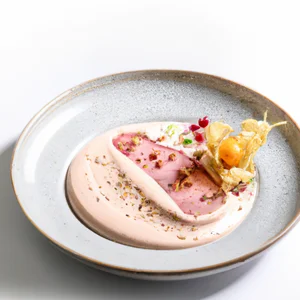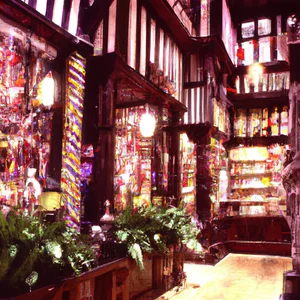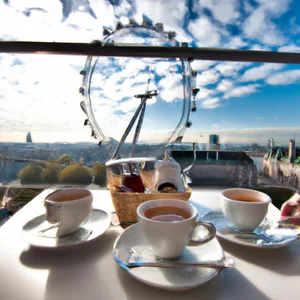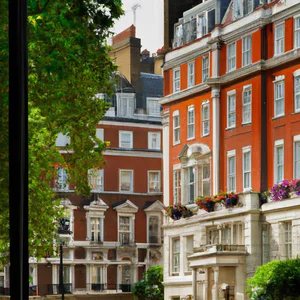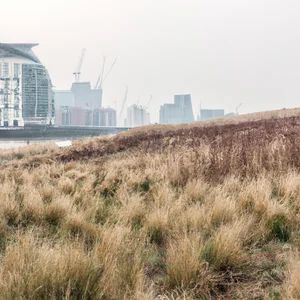Book your experience
Treasure Hunt at the British Museum: Interactive tour of the treasures of the world
Treasure Hunt at the British Museum: an interactive tour of the world’s treasures
So, guys, let’s talk about this fantastic treasure hunt held at the British Museum! It’s a kind of adventure that catapults you into the wonders of the world, and believe me, it’s truly an experience not to be missed.
When I went there for the first time, I remember feeling like an explorer from ancient times, with map in hand and my heart beating fast. In short, you move among statues, mummies and works of art that seem to have been stolen from an adventure film! Well, the nice thing is that it’s not just a walk around the paintings hanging on the wall: there’s an interaction that involves you. You can solve puzzles, discover curiosities and, why not, also have a lot of fun with friends.
I remember that, while we were trying to decipher a riddle about an ancient Egyptian relic, we laughed a lot. I think this is precisely the beauty: it is not just a visit to the museum, but it becomes a game, a moment of sharing and discovery.
And then, guys, let’s talk about the treasures themselves! It’s like walking through a bazaar of cultures and stories. Every object has its own past, and you feel a bit like a detective searching for a mystery. Some say that the museum can seem a little cold and distant, but when you are there, among the wonders, everything is different.
In short, if you happen to be in London, I advise you not to miss this opportunity. It may not be the most classic experience in the world, but I assure you that you will take home memories and stories that will be worth it. Oh, and don’t forget to bring a good camera: there are too many treasures to capture!
Discover the magic of the British Museum: a unique tour
A personal experience among the wonders of the museum
I still remember my first visit to the British Museum, when I crossed the threshold and was immediately surrounded by an atmosphere of wonder. The soft lights illuminated the corridors rich in history, and the scent of ancient books mixed with the fresh air of the atrium. That feeling of being in a place where time seems to have stopped is an experience that every visitor should try. Every step, every corner, tells a story, and the magic of exploring the collections is an invitation to discover the world in a new light.
Practical information for your visit
The British Museum, located in the heart of London, is one of the most iconic museums in the world and entry is free. For a stress-free visit, it is advisable to book a guided tour, which can be easily organized through the museum’s official website. The interactive tours, in particular, are designed to engage the whole family, making the visit a memorable and educational experience.
Unconventional advice
If you want an experience that few people know about, try visiting the museum during its evening opening hours. Every Friday and Saturday, the British Museum offers special events and activities that you won’t find during the day. You could participate in a yoga session among the artworks or attend expert talks, all in a more intimate and relaxed atmosphere.
Cultural and historical impact
The British Museum is not just a place of exhibition; he is a guardian of human history. Its collection includes over eight million objects, which tell stories of ancient and modern civilizations. The Rosetta Stone, for example, is a symbol of the decipherment of hieroglyphics and the understanding of Egyptian culture, while the Parthenon marbles are witnesses to the greatness of ancient Greece. Each piece on display offers a unique insight into our shared history.
Sustainable and responsible tourism
The museum is actively engaged in sustainability practices, such as the use of renewable energy and initiatives to reduce waste. Choosing to visit the British Museum not only enriches your cultural knowledge, but also contributes to more responsible tourism. Furthermore, the museum has implemented educational programs that raise visitors’ awareness of the importance of preserving world heritage.
An activity not to be missed
I recommend you take part in one of the treasure hunts organized by the museum, an engaging activity that will allow you to explore the galleries in a fun and interactive way. Armed with a map and clues, you can discover hidden works of art and participate in challenges that stimulate curiosity and creativity.
Myths and misconceptions
A common misconception is that the British Museum is only for history or art enthusiasts. In reality, the museum is a place of discovery for anyone, regardless of their previous knowledge. The exhibits are designed to engage and inspire visitors of all ages, making each visit unique and memorable.
A final reflection
After spending hours exploring this treasure trove, you’ll be won over by the question: which story from these ancient civilizations resonates most with you? The magic of the British Museum lies not just in its objects, but in the stories that each of us he can discover and take with him.
Treasure Hunt: Explore with the family
A personal experience not to be forgotten
I vividly remember my first visit to the British Museum, not so much for the treasures on display, but for the excitement of a treasure hunt I had organized for my family. Armed with maps, clues and a bit of healthy competition, we ventured through the museum’s rooms, transforming the entire experience into an engaging game. Every discovery, every correct answer, was a small triumph that brought us closer as a family, making the visit not only educational, but also incredibly fun.
Practical and up-to-date information
The British Museum, located in the heart of London, offers a wide range of family activities, including the possibility of organizing personalized treasure hunts. You can download resources from their official website British Museum Families to plan your adventure, with suggestions for riddles and routes. Also take advantage of the available apps that can guide you through the various collections interactively, making your visit even more engaging.
Unconventional advice
A little secret that only true connoisseurs know is that you can create a thematic treasure hunt. For example, choose a theme like “Ancient Civilizations” and challenge your family to find specific objects related to that culture, such as Egyptian figurines or Greek pottery. This not only makes the experience more interactive, but also stimulates curiosity and learning.
The cultural and historical impact
The British Museum is not just a place of exhibition, but a great custodian of world history and culture. Through its collections, visitors can explore stories of past civilizations and understand humanity’s shared heritage. The treasure hunt then becomes an opportunity to delve deeper into these stories, making each discovery a piece of a larger puzzle.
Sustainable and responsible tourism
It is important to note that the British Museum promotes sustainable tourism practices, encouraging visitors to respect the works and the environment. Participating in a treasure hunt within museum rules not only enriches the experience, but also contributes to the preservation of these precious works for future generations.
Immerse yourself in the atmosphere
Imagine turning a corner and finding an Egyptian mummy, with your kids rushing to read the label and discuss what life might have been like in ancient Egypt. Each room of the British Museum is a journey to another era, and the treasure hunt makes this discovery even more fascinating, transforming the museum into a labyrinth of adventures.
An activity from try
To make your visit memorable, consider using one of the available scavenger hunt apps, such as “Museum Adventure.” These apps will guide you through the museum with directions and curiosities, making your journey unique and personalized.
Myths to dispel
A common misconception is that museums are boring, reserved only for adults. In reality, the British Museum is a dynamic and interactive place, perfect even for the little ones. Scavenger hunts are just one of the many activities that demonstrate how learning can be fun and engaging.
A final reflection
Have you ever thought about how a simple game can transform an educational experience into an indelible memory? Next time you visit a museum, consider going on a scavenger hunt. You may find that while you search for treasures, you are actually finding something much more precious: time spent with your loved ones.
Iconic treasures: from the Rosetta Stone to the Parthenon marbles
An experience that remains in the heart
I still remember the first time I walked through the doors of the British Museum, a place that seems to pulsate with history at every turn. As I approached the Rosetta Stone, my heart began to beat faster. It wasn’t just a piece of stone; it was the key to deciphering a lost language, a bridge between cultures and eras. The emotion of being in front of such an iconic artefact is indescribable and, for a moment, I felt part of a narrative that spans millennia.
Treasures to discover
The British Museum is home to some of the world’s most iconic treasures, such as the Parthenon Marbles, which tell stories of gods and battles, and the famous Rosetta Stone, which opened doors to understanding Egyptian civilization. These masterpieces are not just objects to be admired, but symbols of a cultural heritage that continues to influence our world. According to the museum’s official website, every year more than six million visitors are enchanted by these wonders, testifying to the importance of preserving and sharing our collective history.
An insider tip
Here’s a little secret: If you want to avoid the crowds and enjoy a more intimate experience, visit the museum early in the morning on weekdays. Not only will you have the opportunity to explore the iconic treasures with more peace of mind, but you will also be able to enjoy coffee at the museum café overlooking the stunning neoclassical architecture, before the masses arrive.
The cultural and historical impact
The Rosetta Stone is not just an archaeological find; it is a testament to the human ability to communicate and understand. Its discovery transformed our knowledge of ancient Egypt, making palpable the stories of a civilization that has fascinated the world for centuries. Likewise, the Parthenon Marbles are not just works of art, but a symbol of Greek democracy and culture, which continues to influence modern societies.
Sustainability and respect for heritage
The British Museum is also committed to sustainable tourism practices, promoting initiatives to reduce the environmental impact of visits. Part of the proceeds from sales in the museum shops is reinvested in the conservation of the finds and the promotion of culture.
Immerse yourself in the story
During your visit, don’t miss the opportunity to take part in one of the thematic guided tours. These experiences offer a unique perspective on iconic treasures, enriching your knowledge and appreciation for art and history. The guide will lead you to discover fascinating anecdotes and little-known details that you wouldn’t find in the information panels.
Debunking myths and misconceptions
A common misconception is that the British Museum is only for history buffs. In fact, its collections are so varied and engaging that they attract visitors of all ages and interests. From natural history to contemporary art, there is something for everyone.
Final reflection
As you leave the British Museum, I invite you to reflect on how these iconic treasures are not just objects of the past, but a fundamental part of our collective identity. What story will you take with you? How will these artifacts influence your understanding of the world and its history? The answer to these questions may surprise you and, above all, enrich you.
Interactive activities: engage your senses
A personal experience
I vividly remember my first encounter with the British Museum. I didn’t go in simply to look at works of art; I was captivated by a multi-sensory experience that transformed my visit into an unforgettable adventure. Each room of the museum is an invitation to explore, touch and listen to the stories that each object tells. Walking through the exhibits, I found myself faced with a stone carving demonstration, where the hands of an expert craftsman danced across the rough surfaces, creating a tangible link between the past and the present.
Practical information
Today, the British Museum offers a range of interactive activities designed to engage visitors of all ages. From mobile apps that guide tours with augmented reality experiences, to hands-on workshops for children and families, there’s something special for everyone. Activities are available in both English and other languages, ensuring accessibility for international visitors. I recommend you check the museum’s official website British Museum for updates on current events and workshops.
An insider tip
A little secret that only the most frequent visitors know is the Activity Room located on the ground floor. Here, you can find a variety of tools and materials to explore different artistic techniques. Often, there are surprise events organized throughout the week, such as calligraphy writing sessions or weaving demonstrations, which can enrich your experience in unexpected ways.
The cultural impact
Interactive activities not only enrich the visit, but also play a crucial role in promoting cultural understanding. Through active engagement, visitors can appreciate the history and craftsmanship of different civilizations, creating a sense of connection and respect for the world’s cultures. This approach makes the British Museum not just a place of exhibition, but a true center of learning and intercultural dialogue.
Sustainability in tourism
Interestingly, the British Museum is committed to sustainability practices. The interactive activities focus on the use of recycled materials and low environmental impact technologies. Attending these sessions not only enriches your experience, but also supports a responsible approach to tourism.
An activity worth trying
If you’re visiting and want to experience something unique, take one of the sensory guided tours that the museum offers periodically. These experiences are designed to stimulate all your senses and allow you to explore the collections in a completely new way, including sounds, touches and aromas related to the objects on display.
Myths and misconceptions
A common myth is that the British Museum is a place solely for observation; instead, it is a place to live. Many visitors don’t realize that they can actively interact with the exhibits and participate in hands-on workshops. This mistake can lead to more superficial experiences, while the deep interaction with art and culture greatly enriches the visit.
Final reflection
As you leave the British Museum, I invite you to reflect on how these interactive activities have allowed you to see the world with new eyes. What was yours Favorite sensory experience during the visit? Learning to engage your senses is not just an opportunity for fun, but a way to connect more deeply with the history and culture around us.
Little-known secrets of the British Museum
A personal journey among hidden wonders
When I first visited the British Museum, I thought I already knew everything about its iconic treasures. But, while I was getting lost among the crowded rooms, a curator revealed a secret to me that changed the way I perceived the museum: the presence of a small collection of unexpected objects, called “The Museum of the World”. This interactive experience, combining art and technology, allowed me to explore the history of humanity through a simple touch, revealing connections between different cultures and times that I would never have imagined.
Practical information on the museum’s secrets
The British Museum, located in the heart of London, is more than just a container of historical artefacts; it is a place where stories intertwine. Among its 8 million objects, many are shrouded in little-known anecdotes. For example, did you know that the famous Rosetta Stone, although a symbol of decipherment, is only one of 14 similar stones in the museum? Delving into these stories, available in guided tours and audio guides, is a fantastic way to discover the lesser-known side of this institution.
An insider tip
A little-known trick for visitors is to head to “Room 10,” which houses the collection of coins and medals. Here, in addition to admiring the works, you can participate in periodic workshops that allow you to experience history first-hand through numismatics. These activities are not only fascinating, but also offer a rare opportunity for direct interaction with the artifact.
The cultural impact of the British Museum
The British Museum represents an important cultural and historical crossroads. Its vast collection, which ranges from prehistory to the modern era, is a silent witness to the interactions and exchanges between civilizations. However, it is important to address the debate on the restitution of cultural objects, a hot topic that continues to influence the global museum landscape.
Sustainable tourism practices
The British Museum has adopted several sustainability practices. These include the use of green technologies for heating and cooling exhibition spaces and a commitment to reducing the use of plastic during events and activities. These initiatives demonstrate how even a historic institution can embrace responsible tourism.
Immerse yourself in the atmosphere of the museum
Imagine entering the hall of the ancient Egyptians, the scent of ancient wood and stone filling the air, as your eyes rest on a mummy wrapped in intricate bandages. The feeling of being in front of a piece of history envelops you, and the reverential silence of the visitors around you makes the experience almost magical. This is the power of the British Museum: it can transport you to another time and place with just a glance.
An activity not to be missed
Don’t miss the opportunity to take part in one of the museum’s thematic guided tours, where expert curators tell fascinating stories linked to specific objects. These visits offer a unique experience, revealing details that escape casual visitors.
Myths and misconceptions
A common misconception is that the British Museum is only for history buffs. In fact, the museum offers something for everyone: from modern sculpture to contemporary art artifacts. It is a place where even the less experienced can find inspiration and wonder.
A personal reflection
Every time I visit the British Museum, I ask myself: what stories remain to be discovered within its walls? Each object has a secret to reveal, and each visit is an opportunity to see the world from a new perspective. And you, what secrets would you be curious to explore on your next trip?
Sustainability in tourism: the museum and the environment
When I visited the British Museum for the first time, I remember being struck not only by the magnificence of its collections, but also by the atmosphere of care and respect for the environment that permeated the place. As I admired the Rosetta Stone, an illustration of how history can be preserved, I also noticed the museum’s commitment to sustainability, which is reflected in every aspect of its management.
A concrete commitment to the environment
In recent years, the British Museum has adopted various eco-friendly practices, from reducing energy consumption to using recycled materials in its exhibitions. According to a report from the museum, 90% of energy comes from renewable sources, a remarkable achievement for such a historic and prestigious institution. Additionally, the museum has launched initiatives to reduce waste and encourage sustainable mobility among visitors, such as enhancing nearby public transportation options.
An insider tip
An experience not to be missed is to participate in one of the sustainable tours organized by the museum. These tours will not only guide you through the artistic wonders, but will also provide you with detailed information on ongoing eco-friendly practices. It’s a way to explore history while learning about the importance of sustainability in the current context.
The cultural impact of sustainability
The British Museum is not just a repository of treasures from the past; it also represents a point of reference for the future of cultural tourism. The commitment to sustainability is a powerful message, which highlights how tourism can be a positive force for society and the environment, promoting awareness and education.
Immerse yourself in the atmosphere
Imagine walking through the vast corridors of the museum, surrounded by works of art that tell stories of past civilizations, while your heart fills with a sense of responsibility towards the planet. Every step you take is a step towards a more sustainable future, not only for the museum but for the entire world.
An activity worth trying
For an experience that combines culture and sustainability, I recommend you visit the museum restaurant, where the dishes are prepared with local and seasonal ingredients. Not only will you enjoy a delicious meal, but you will also have the certainty that your lunch has a low environmental impact.
Myths and misconceptions
A common misconception is that museums, being historic institutions, cannot adapt to modern sustainability practices. On the contrary, the British Museum demonstrates that it is possible to combine tradition and innovation, offering an example for other institutions to follow.
Final reflection
At the end of your visit, ask yourself: How can I contribute to sustainability in tourism? Every small gesture counts, and the British Museum is a living testament to how culture and the environment can coexist in harmony. The next time you walk through the doors of a museum, remember that you are participating in a larger conversation about responsibility and respect for our planet.
A journey through time: history and culture in one place
An indelible memory
I remember my first visit to the British Museum, an experience that transformed my perception of history. As I walked under the great glass roof of the Great Court, time seemed to dissolve. The echo of visitors’ footsteps mixed with the silent stories of the ancient civilizations on display. It was in that moment that I understood the true essence of this museum: it is not just a place that houses objects, but a portal that leads us through millennia of culture and innovation.
Practical information
The British Museum, located in the heart of London, is open to the public all days with free entry. However, it is advisable to book in advance to avoid long waits, especially during weekends and holidays. Audio guides are available in several languages and offer detailed insights into the exhibitions. You can also download the museum’s official app, which offers virtual tours and interactive maps to make your visit easier.
An insider tip
A little known secret is that the museum offers night tours once a month. These exclusive events allow you to explore the galleries in a magical and peaceful atmosphere, away from the crowds. Booking in advance is essential, as places are limited. Don’t miss the chance to experience the museum in a completely different way!
The cultural impact
The British Museum is much more than just a collection of artefacts; it is a symbol of how culture can bring people together. With over eight million objects, its collection tells the story of civilizations around the world, from Egypt to Asia, from Europe to Africa. Each piece is a testimony to human experiences, achievements and challenges faced throughout history. This museum plays a crucial role in promoting intercultural understanding and the appreciation of diversity.
Sustainable tourism practices
In an age where sustainability is key, the British Museum is committed to reducing its environmental impact. Through initiatives such as the use of renewable energy and environmental education programs, the museum demonstrates that it is possible to combine cultural conservation with ecological responsibility. By participating in museum events and programs, visitors can contribute to this important goal.
Soak up the atmosphere
Imagine walking through the illuminated galleries, surrounded by objects that have spanned the centuries. Each room tells a story: from the grandeur of the marbles of the Parthenon to the delicacy of the Chinese ceramics. It’s as if the walls themselves breathe history, inviting you to discover the secrets of a fascinating past.
An activity worth trying
For an immersive experience, join one of the art workshops the museum offers regularly. These hands-on events will allow you to explore ancient artistic techniques, such as ceramic painting or mosaic creation, under the guidance of experts. It’s a unique way to connect with history through creativity.
Myths to dispel
It is common to think that the British Museum is only for scholars or those with an in-depth knowledge of history. In reality, the museum is accessible to all, with routes and activities designed even for the youngest. Every visitor, whether a history buff or a curious person, will find something interesting and engaging.
Final reflection
Visit the British Museum and ask yourself: How can the history I explore here influence my present? In an ever-changing world, understanding our past is essential to building a more conscious and inclusive future. This time travel is not only an educational experience, but an opportunity to reflect on who we are and where we want to go.
Local experience: Coffee in the museum gardens
Imagine ending your adventure in the British Museum, satisfied and full of stories to tell. The emotion of having solved puzzles and discovered ancient treasures is palpable, but there is a way to prolong this magical experience: a coffee in the museum gardens.
A corner of tranquility
After exploring the wonders of the museum, a moment’s pause in the gardens offers a fascinating contrast. These green spaces, often overlooked by hasty visitors, are a serene refuge where time seems to stand still. The gardens of the British Museum are a true oasis in the heart of the bustle of London. Here, sitting on a bench surrounded by lush plants and colorful flowers, you can reflect on the civilizations that have followed one another over time.
Practical information
Inside the museum, the Great Court Café is the perfect place to recharge your batteries. It offers a selection of high-quality coffees, fine teas and fresh pastries. Be sure to try a scone with cream and jam, a quintessentially British treat that will make you feel like a true Londoner. The café is open every day from 9am to 5.30pm and on weekends until 6pm. Don’t forget to keep an eye on the seasonal offers that frequently enrich the menu.
Unconventional advice
Here’s an insider secret: if you can, visit the café early in the morning, before the museum opens. Not only will you have time to enjoy your coffee in peace, but you will also be able to enjoy the view of the gardens in the golden morning light, as the museum prepares to welcome visitors. This is the ideal time to take photos without the crowds.
The cultural impact
The gardens of the British Museum are not only a place of refreshment, but also a symbol of how art and nature can coexist. Here, it is possible to reflect on the importance of preserving not only historical artifacts, but also the green spaces that surround us. This approach to sustainability is increasingly relevant in modern tourism, where caring for the environment and enhancing public spaces are issues of fundamental importance.
An experience worth trying
After a refreshing coffee, why not take a walk in the gardens? You could also bring a book with you to read, immersing yourself in a moment of pure tranquility. Or, if you’re feeling adventurous, you can continue to explore the museum’s surroundings, such as nearby Bloomsbury, a neighborhood rich in history and culture.
Final reflection
After discovering the treasures of the British Museum and drinking coffee in its gardens, we invite you to consider: how important is it for you to find moments of calm on a trip? The next time you visit a museum, take the time to savor the environment around it as well. In a busy world, these breaks can enrich your experience more than you can imagine.
Unconventional tips for an unforgettable visit to the British Museum
A unique experience: my discovery
During my latest visit to the British Museum, I happened to come across a little corner of the museum that most visitors tend to overlook. As I followed the treasure hunt map, I found myself in a less crowded room dedicated to African art. Here, a carved wooden work of art caught my attention, telling stories of distant cultures. It was a moment of pure magic, where I realized that the beauty of museums lies even in the most hidden details.
Discover hidden gems
When you think of the British Museum, the first things that come to mind are the Rosetta Stone or the Parthenon marbles. However, the museum is a true treasure trove of lesser-known treasures that are worth exploring. Here are some tips for discovering these secret corners:
- Visit the room dedicated to the art and culture of Asia: here you will find works of art that tell millenary stories, from Japanese Buddhas to Chinese ceramics.
- Don’t forget the Museum Garden: a quiet place where you can stop to reflect and enjoy a coffee, away from the hustle and bustle of the exhibition rooms.
- Talk to the curators: Many times, the guides and curators are happy to share curiosities and anecdotes that you wouldn’t find in tour guides.
An insider tip
If you really want to have a different experience, try visiting the museum during the evening hours. Often, the British Museum organizes special events and night visits which offer a unique, almost magical atmosphere. Furthermore, the number of visitors is significantly reduced, allowing you to appreciate the exhibits without the crowds.
Cultural impact and sustainable practices
The British Museum is not just a place of exhibition, but a true cultural institution that promotes global understanding. Its mission to educate and preserve the world’s cultures is paramount, and the museum is working to adopt sustainable tourism practices, such as the use of eco-friendly materials and promoting events that raise visitor awareness of environmental issues.
Immerse yourself in the atmosphere
Imagine walking among the ancient statues, breathing in the air full of history, while the sound of your footsteps echoes through the rooms. Each piece on display has a story to tell and, through the treasure hunt, you will have the opportunity to discover not only the objects, but also the emotions they arouse.
A final reflection
The next time you visit the British Museum, I invite you to be amazed by the hidden wonders. What do you think? Which corner of the museum could prove to be your personal treasure? The beauty of discovery is that each visit is unique, and each time we can find something new that speaks to us.
Special events: discover the temporary exhibitions not to be missed
An experience to remember
I remember the moment I crossed the threshold of the British Museum during one of its most anticipated temporary exhibitions, dedicated to contemporary African art. The emotion in the air was palpable, with visitors of all ages crowding the corridors, all tuned into one vibration: the beauty of a culture making its way onto the global landscape. That exhibition was not just an exhibition, but a journey through stories and traditions that left an indelible mark on my heart.
Practical information
The British Museum is known not only for its permanent collection, but also for its temporary exhibitions that attract the attention of experts and enthusiasts. These exhibitions vary in theme and duration, so it is always advisable to check the museum’s official website for updates. A great resource is the British Museum website, where you can find detailed information on current exhibitions and tickets.
An insider tip
If you want a truly unique experience, try to attend one of the opening nights of the temporary exhibitions. These events offer the opportunity to explore the exhibition in a more intimate atmosphere, often with experts sharing fascinating anecdotes and details. Plus, access is limited, meaning fewer crowds and more space to appreciate art authentically.
The cultural impact of temporary exhibitions
Temporary exhibitions at the British Museum not only enrich the visit, but also play a crucial role in promoting culture and history. Each exhibition is an opportunity to delve into social, political and historical issues, contributing to a global dialogue. For example, exhibitions dedicated to African art and history, like the one I visited, highlight often overlooked narratives, promoting greater cross-cultural understanding.
Sustainability and responsible tourism
In an age where sustainability is key, the British Museum is committed to ensuring its exhibitions are environmentally friendly. Many temporary exhibitions are curated with particular attention to environmental impact, using recyclable materials and sustainable practices. Participating in these events also means supporting responsible and aware tourism.
An invitation to explore
Imagine walking among works of art that tell stories of ancient and contemporary civilisations, while your gaze gets lost in the details of an artefact. I suggest that you do not miss the opportunity to visit a specific temporary exhibition, perhaps an exhibition of contemporary Japanese art or African art, which will not only enlighten you, but enrich your understanding of cultural diversity.
Myths and misconceptions
A common misconception is that temporary exhibitions are less significant than the permanent collection. In fact, these exhibitions offer a unique and dynamic perspective, allowing visitors to explore topics that may not be covered in fixed collections. Each exhibition is an opportunity to discover and interact with new ideas and artistic forms.
A final reflection
What story do you expect to discover in the next temporary exhibition at the British Museum? The beauty of these events is that each visit can be a transformative experience, challenging your perceptions and inviting you to explore the world from a new perspective. Don’t miss the opportunity to be part of this cultural adventure!

 Architecture and Design
Architecture and Design Cities and Regions
Cities and Regions Culture and History
Culture and History Events and Festivals
Events and Festivals Fashion and Shopping
Fashion and Shopping Food and Wine
Food and Wine Nature and Adventure
Nature and Adventure Unique Experiences
Unique Experiences


















